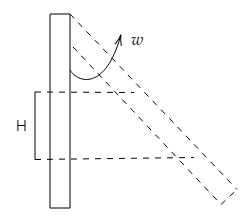Answer
334.2k+ views
Hint: In order to solve this question, we need to use the energy conservation principle. The total mechanical energy of the system will always be conserved for the two instants given in the question. The law of conservation of energy states that the total mechanical energy of a system always remains conserved.
Complete step by step answer:
Given,
Mass of the rod $ = m$
Length of the rod $ = l$
Angular velocity $ = \omega $
In this question, we can clearly see that the exchange of energy takes places. At some point, the kinetic energy is converted into potential energy and at some other point, potential energy is converted into kinetic energy.
According to the law of conservation of energy,
Kinetic energy $ = $ Potential energy
$\dfrac{1}{2}m{v^2} = mgh$
Where,
$m$ is the mass of the rod
$v$ is the velocity of the rod
$g$ is the acceleration due to gravity
$h$ is the height attained by the rod
On further solving, we get,
$\dfrac{1}{2}{v^2} = gh$
$h = \dfrac{{{v^2}}}{{2g}}.....(1)$
On putting $v = \dfrac{{\omega L}}{2}$ in equation (1),
$h = {\left( {\dfrac{{\omega L}}{2}} \right)^2} \times \dfrac{1}{{2g}}$
$h = \dfrac{{{\omega ^2}{L^2}}}{4} \times \dfrac{1}{{2g}}$
$h = \dfrac{{{\omega ^2}{L^2}}}{{8g}}$
$h = \dfrac{{{\omega ^2}{L^2}}}{{8g}}$
So, the height at which the centre of mass will rise from the lowest position is $h = \dfrac{{{\omega ^2}{L^2}}}{{8g}}$.
Note:The motion of the centre of mass of any system of particles is always independent of the internal forces acting on it. The centre of mass moves in a way that the whole mass of the system is concentrated at that point and the external force is acting on only that single point.
Complete step by step answer:
Given,
Mass of the rod $ = m$
Length of the rod $ = l$
Angular velocity $ = \omega $
In this question, we can clearly see that the exchange of energy takes places. At some point, the kinetic energy is converted into potential energy and at some other point, potential energy is converted into kinetic energy.
According to the law of conservation of energy,
Kinetic energy $ = $ Potential energy
$\dfrac{1}{2}m{v^2} = mgh$
Where,
$m$ is the mass of the rod
$v$ is the velocity of the rod
$g$ is the acceleration due to gravity
$h$ is the height attained by the rod
On further solving, we get,
$\dfrac{1}{2}{v^2} = gh$
$h = \dfrac{{{v^2}}}{{2g}}.....(1)$
On putting $v = \dfrac{{\omega L}}{2}$ in equation (1),
$h = {\left( {\dfrac{{\omega L}}{2}} \right)^2} \times \dfrac{1}{{2g}}$
$h = \dfrac{{{\omega ^2}{L^2}}}{4} \times \dfrac{1}{{2g}}$
$h = \dfrac{{{\omega ^2}{L^2}}}{{8g}}$
$h = \dfrac{{{\omega ^2}{L^2}}}{{8g}}$
So, the height at which the centre of mass will rise from the lowest position is $h = \dfrac{{{\omega ^2}{L^2}}}{{8g}}$.
Note:The motion of the centre of mass of any system of particles is always independent of the internal forces acting on it. The centre of mass moves in a way that the whole mass of the system is concentrated at that point and the external force is acting on only that single point.
Recently Updated Pages
When people say No pun intended what does that mea class 8 english CBSE

Name the states which share their boundary with Indias class 9 social science CBSE

Give an account of the Northern Plains of India class 9 social science CBSE

Change the following sentences into negative and interrogative class 10 english CBSE

Advantages and disadvantages of science

10 examples of friction in our daily life

Trending doubts
Fill the blanks with the suitable prepositions 1 The class 9 english CBSE

Which are the Top 10 Largest Countries of the World?

Difference between Prokaryotic cell and Eukaryotic class 11 biology CBSE

Differentiate between homogeneous and heterogeneous class 12 chemistry CBSE

10 examples of evaporation in daily life with explanations

One cusec is equal to how many liters class 8 maths CBSE

Give 10 examples for herbs , shrubs , climbers , creepers

Difference Between Plant Cell and Animal Cell

How do you graph the function fx 4x class 9 maths CBSE




